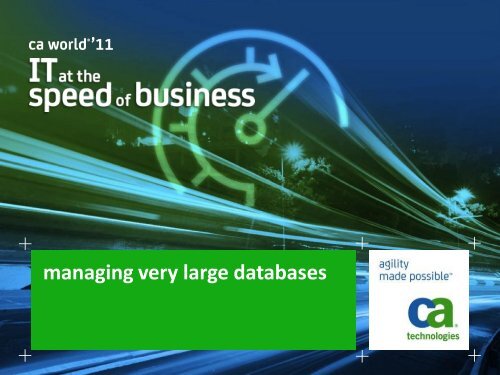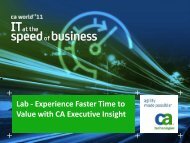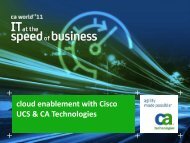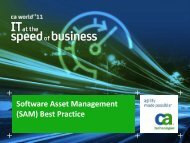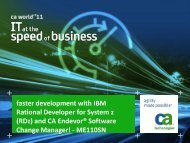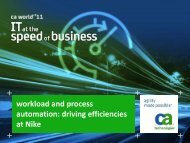Managing Very Large Databases - CA.com
Managing Very Large Databases - CA.com
Managing Very Large Databases - CA.com
- No tags were found...
Create successful ePaper yourself
Turn your PDF publications into a flip-book with our unique Google optimized e-Paper software.
Next Generation Mainframe Managementmi440snmanaging very large databasesDick Weiland
abstract— As <strong>CA</strong> IDMS database sizes grow, organizations face anumber of challenges generated by very large volumes ofdata. This session examines these challenges and coversstrategies for managing these environments, focusing on theuse of database segmentation and database page growth.3 Copyright © 2011 <strong>CA</strong>. All rights reserved. All trademarks, trade names, service marks and logos referenced herein belong to theirrespective <strong>com</strong>panies. <strong>CA</strong> confidential and proprietary. No unauthorized copying or distribution permitted.
agenda— Introduction— Space— Time— Summary4 Copyright © 2011 <strong>CA</strong>. All rights reserved. All trademarks, trade names, service marks and logos referenced herein belong to theirrespective <strong>com</strong>panies. <strong>CA</strong> confidential and proprietary. No unauthorized copying or distribution permitted.
what are the major considerations of a very large database(VLDB)?— Space− The number of pages available to the database— Time− Application processing− Maintenance processing5 Copyright © 2011 <strong>CA</strong>. All rights reserved. All trademarks, trade names, service marks and logos referenced herein belong to theirrespective <strong>com</strong>panies. <strong>CA</strong> confidential and proprietary. No unauthorized copying or distribution permitted.
space— Page Groups− Dividing the areas of the database across multiple page groups increases thenumber of pages available to the database— Altering the number of records that can be stored on a databasepage (radix point)− The standard maximum number of user records per page is 255− If the database contains a large number of very small records• The maximum records per page could be increased up to 2727 to store moreoccurrences per page• This reduces the number of available pages.− If the database contains extremely large records• The number of records per page can be reduced to a maximum of 3• This increases the total number of pages that can be defined within the pagegroup.6 Copyright © 2011 <strong>CA</strong>. All rights reserved. All trademarks, trade names, service marks and logos referenced herein belong to theirrespective <strong>com</strong>panies. <strong>CA</strong> confidential and proprietary. No unauthorized copying or distribution permitted.
spacepage groups— Page groups and radix points are defined on a segment basis— All segments within the same page group should have thesame radix point— Mixed Page Group Support− Allows a single run-unit to access areas from multiple page groups− Enabled when defining the DBNAME to be used for the run-unitCREATE DBNAME R170DBTB.RJWMIXED PAGE GROUP BINDS ALLOWEDINCLUDE SEGMENT RJWSEGINCLUDE SEGMENT SYSDICTINCLUDE SEGMENT SYSMSG;7 Copyright © 2011 <strong>CA</strong>. All rights reserved. All trademarks, trade names, service marks and logos referenced herein belong to theirrespective <strong>com</strong>panies. <strong>CA</strong> confidential and proprietary. No unauthorized copying or distribution permitted.
spacepage groups— When using Mixed Page Group Support there are restrictionsthat must be observed− Sets, indexes, and referential constraints cannot cross page groupboundaries− Record names must be unique across all areas accessed under a singlerun-unit− Unqualified FIND/OBTAIN DML <strong>com</strong>mands should be avoided8 Copyright © 2011 <strong>CA</strong>. All rights reserved. All trademarks, trade names, service marks and logos referenced herein belong to theirrespective <strong>com</strong>panies. <strong>CA</strong> confidential and proprietary. No unauthorized copying or distribution permitted.
spacepage groupsScenario 1:— The following database structure is to be separated into twopage groups, each containing a single area.— To allow for this change set ORD-ITEM must be replaced bysome other constructORDERORD-NUM <strong>CA</strong>LCORDER-AREAORD-ITEMSORTED NPOPROD-NUMITEMORD-ITEMITEM-AREAVIA9 Copyright © 2011 <strong>CA</strong>. All rights reserved. All trademarks, trade names, service marks and logos referenced herein belong to theirrespective <strong>com</strong>panies. <strong>CA</strong> confidential and proprietary. No unauthorized copying or distribution permitted.
spacepage groups— All record names accessed by a run-unit must be unique(as with other non-SQL defined databases )− May be<strong>com</strong>e an issue when Mixed Page Group Support is used with asegmentation strategy— Use of unqualified FIND/OBTAIN DB-KEY <strong>com</strong>mands can leadto erroneous resultsChange: OBTAIN DB-KEY IS WS-DBKEYtoOBTAIN ITEM DB-KEY IS WS-DBKEYorOBTAIN DB-KEY IS WS-DBKEY PAGE-INFO WS-PAGE-INFO12 Copyright © 2011 <strong>CA</strong>. All rights reserved. All trademarks, trade names, service marks and logos referenced herein belong to theirrespective <strong>com</strong>panies. <strong>CA</strong> confidential and proprietary. No unauthorized copying or distribution permitted.
timeapplication processing— Horizontal segmentation− Divides occurrences of database entities along a high-level businessspecification− Allows portions of the database to be independent of each other— Potential segmentation criteria− Geographic/<strong>com</strong>pany/division− Time/date relationships− A manufactured key value— Typically a portion of the database cannot be segmentedacross the selected criteria and is referred to as the ‘<strong>com</strong>mon’segment14 Copyright © 2011 <strong>CA</strong>. All rights reserved. All trademarks, trade names, service marks and logos referenced herein belong to theirrespective <strong>com</strong>panies. <strong>CA</strong> confidential and proprietary. No unauthorized copying or distribution permitted.
timeapplication processing— Horizontal segmentation like Mixed Page Group Support hasthe same type of restrictions− Sets, indexes, and referential constraints cannot cross segmentboundaries− Record names within non-SQL defined database must be unique— If Mixed Page Group Support is used with segmentation− Unqualified DML <strong>com</strong>mands should be avoided15 Copyright © 2011 <strong>CA</strong>. All rights reserved. All trademarks, trade names, service marks and logos referenced herein belong to theirrespective <strong>com</strong>panies. <strong>CA</strong> confidential and proprietary. No unauthorized copying or distribution permitted.
timeapplication processing— First, separate those areas that contain customer-specific datathat can be divided by location from data that is <strong>com</strong>mon toboth European and North American customersCommonAreasCustomerSpecificAreas17 Copyright © 2011 <strong>CA</strong>. All rights reserved. All trademarks, trade names, service marks and logos referenced herein belong to theirrespective <strong>com</strong>panies. <strong>CA</strong> confidential and proprietary. No unauthorized copying or distribution permitted.
timeapplication processing— Define each group of areas to its own segment— Create a second segment for the customer-specific areas— Assign each segment to their own page group if neededCommonAreasCustomerSpecificAreasCustomerSpecificAreasCUSTCOMPage Group 0CUSTEURPage Group 1CUSTNAPage Group 218 Copyright © 2011 <strong>CA</strong>. All rights reserved. All trademarks, trade names, service marks and logos referenced herein belong to theirrespective <strong>com</strong>panies. <strong>CA</strong> confidential and proprietary. No unauthorized copying or distribution permitted.
timeapplication processingCUSTCOMCUSTEURCUSTNACare should be taken to avoid updating the <strong>com</strong>mon segment andanother segment in the same run-unit due to recoveryconsiderations19 Copyright © 2011 <strong>CA</strong>. All rights reserved. All trademarks, trade names, service marks and logos referenced herein belong to theirrespective <strong>com</strong>panies. <strong>CA</strong> confidential and proprietary. No unauthorized copying or distribution permitted.
timemaintenance operations— Segmentation− Can reduce the volume of data to be processed and therefore the timeto perform the following processes• Unload/reload of the database• Index tuning− May minimize the portion of the database affected and the relatedoutage times for the following operations• Restructures• Recovery20 Copyright © 2011 <strong>CA</strong>. All rights reserved. All trademarks, trade names, service marks and logos referenced herein belong to theirrespective <strong>com</strong>panies. <strong>CA</strong> confidential and proprietary. No unauthorized copying or distribution permitted.
timemaintenance operations— The following utilities will reduce the processing time or thelength of an outage when processing a VLDB− REORG• Reduces the time to perform an unload/reload operation by processing thedatabase in multiple concurrent slices− EZ-REORG (third-party)• Reduces the outage time for a database during an unload/reload operation byallowing the operation to occur against a copy of the database whileconcurrent access is allowed against the original database− TUNE INDEX• Can eliminate outages by concurrently tuning indexes while normal processingis occurring against the database21 Copyright © 2011 <strong>CA</strong>. All rights reserved. All trademarks, trade names, service marks and logos referenced herein belong to theirrespective <strong>com</strong>panies. <strong>CA</strong> confidential and proprietary. No unauthorized copying or distribution permitted.
summary— To implement a very large database using <strong>CA</strong> IDMS requiresthe ability to provide− Adequate space for the data− A method to perform application and maintenance processing within thenecessary timeframe— <strong>CA</strong> IDMS provides the architecture and the support code tofulfill both of these needs— However, to successfully implement this type of environmentrequires planning on both the database and application designlevels22 Copyright © 2011 <strong>CA</strong>. All rights reserved. All trademarks, trade names, service marks and logos referenced herein belong to theirrespective <strong>com</strong>panies. <strong>CA</strong> confidential and proprietary. No unauthorized copying or distribution permitted.
Q & A
Session # MI440SNPlease scan thisimage to fill inyour sessionsurvey on amobile device or<strong>com</strong>plete a hardcopy sessionevaluation form
thank you
terms of this presentationfor information purposes onlyCopyright © 2011 <strong>CA</strong>. All rights reserved. All trademarks, trade names, service marks and logos referenced herein belong totheir respective <strong>com</strong>panies.This presentation was based on current information and resource allocations as of November 2011 and is subject to change orwithdrawal by <strong>CA</strong> at any time without notice. Notwithstanding anything in this presentation to the contrary, this presentationshall not serve to (i) affect the rights and/or obligations of <strong>CA</strong> or its licensees under any existing or future written licenseagreement or services agreement relating to any <strong>CA</strong> software product; or (ii) amend any product documentation orspecifications for any <strong>CA</strong> software product. The development, release and timing of any features or functionality described inthis presentation remain at <strong>CA</strong>’s sole discretion. Notwithstanding anything in this presentation to the contrary, upon the generalavailability of any future <strong>CA</strong> product release referenced in this presentation, <strong>CA</strong> will make such release available (i) for sale tonew licensees of such product; and (ii) to existing licensees of such product on a when and if-available basis as part of <strong>CA</strong>maintenance and support, and in the form of a regularly scheduled major product release. Such releases may be made availableto current licensees of such product who are current subscribers to <strong>CA</strong> maintenance and support on a when and if-availablebasis. In the event of a conflict between the terms of this paragraph and any other information contained in this presentation,the terms of this paragraph shall govern.Certain information in this presentation may outline <strong>CA</strong>’s general product direction. All information in this presentation is foryour informational purposes only and may not be incorporated into any contract. <strong>CA</strong> assumes no responsibility for the accuracyor <strong>com</strong>pleteness of the information. To the extent permitted by applicable law, <strong>CA</strong> provides this presentation “as is” withoutwarranty of any kind, including without limitation, any implied warranties or merchantability, fitness for a particular purpose, ornon-infringement. In no event will <strong>CA</strong> be liable for any loss or damage, direct or indirect, from the use of this document,including, without limitation, lost profits, lost investment, business interruption, goodwill, or lost data, even if <strong>CA</strong> is expresslyadvised in advance of the possibility of such damages. <strong>CA</strong> confidential and proprietary. No unauthorized copying or distributionpermitted.26


